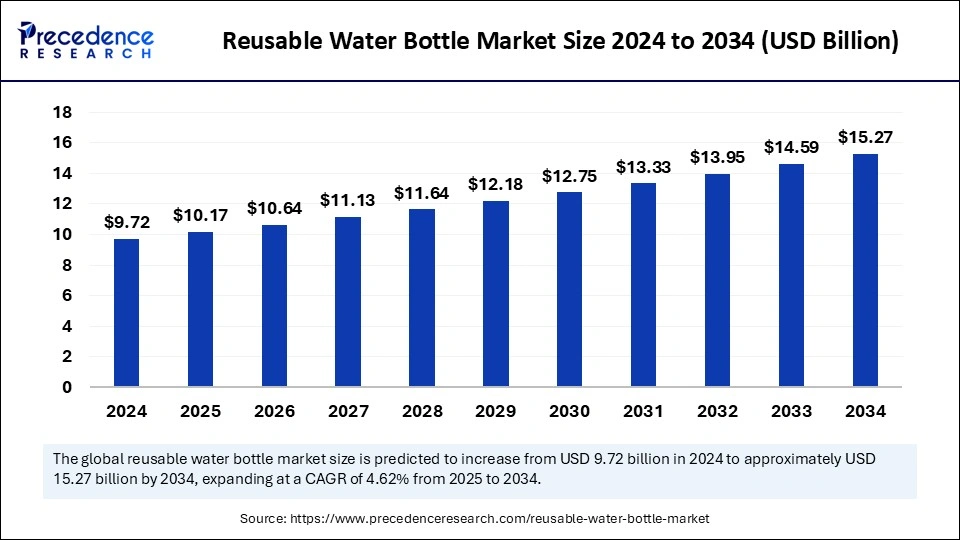Reusable Water Bottle Market is projected to reach USD 15.27 billion by 2034
The global reusable water bottle market is expected to grow from USD 9.72 billion in 2024 to approximately USD 15.27 billion by 2034, registering a CAGR of 4.62%.
Reusable Water Bottle Market Key Insights
- Asia Pacific dominated the market by holding more than 40% of market share in 2024.
- North America is expected to grow at a CAGR of 5.2% during the forecast period of 2025 to 2034.
- By material, the plastic segment contributed the largest market share of 36% in 2024.
- By material, the stainless-steel segment is expanding at a CAGR of 5% over the forecast period of 2025 to 2034.
- By distribution channel, the hypermarkets and supermarkets segment held the largest market share of 40% in 2024.
- By distribution channel, the online sales segment is projected to grow at a CAGR of 5.4% during the forecast period.

The reusable water bottle market is experiencing steady growth, driven by increasing environmental consciousness, rising health awareness, and government initiatives promoting sustainability. Consumers are shifting away from single-use plastic bottles due to concerns about plastic pollution and its impact on the environment. Reusable water bottles, made from materials like stainless steel, glass, and BPA-free plastics, offer an eco-friendly and cost-effective alternative. The market is further fueled by innovations in design, functionality, and smart hydration tracking features. As the demand for sustainable products continues to rise, the reusable water bottle industry is expected to expand significantly over the next decade.
Sample Link: https://www.precedenceresearch.com/sample/5707
Market Drivers
Several key factors are propelling the growth of the reusable water bottle market
- Rising Environmental Awareness – Growing concerns over plastic waste and ocean pollution are pushing consumers to adopt reusable water bottles as a sustainable alternative.
- Government Regulations & Bans on Single-Use Plastics – Many governments worldwide are enforcing bans and restrictions on single-use plastic bottles, boosting the demand for reusable options.
- Health & Wellness Trends – Increasing awareness of hydration’s benefits is driving consumers to invest in high-quality reusable water bottles for daily use.
- Cost-Effectiveness & Convenience – Compared to single-use plastic bottles, reusable options offer long-term cost savings and greater convenience for everyday hydration.
- Technological Advancements – Smart water bottles with features like hydration tracking, temperature control, and self-cleaning mechanisms are attracting tech-savvy consumers.
- Corporate & Institutional Adoption – Companies and schools are adopting reusable water bottles as part of their sustainability initiatives, further driving market growth.
Opportunities
The reusable water bottle market presents several growth opportunities
- Expansion in Developing Markets – Increasing awareness of sustainability in emerging economies presents opportunities for market penetration.
- Innovative Designs & Customization – Personalization, ergonomic designs, and unique bottle features can attract a wider range of consumers.
- Smart & Self-Cleaning Bottles – The integration of UV-C sterilization, app connectivity, and hydration reminders is enhancing product appeal.
- Corporate Sustainability Programs – Companies are increasingly investing in branded reusable water bottles for employees and marketing campaigns.
- Sports & Outdoor Market Growth – The rising popularity of fitness, sports, and outdoor activities is driving demand for durable, insulated water bottles.
Challenges
Despite its growth potential, the reusable water bottle market faces some challenges
- High Initial Costs – Premium reusable bottles made from stainless steel or glass are more expensive than single-use plastic alternatives, potentially limiting adoption in price-sensitive markets.
- Consumer Resistance to Habit Change – Some consumers still prefer the convenience of disposable plastic bottles and may be reluctant to switch.
- Competition from Low-Cost Alternatives – The availability of cheaper, non-branded reusable bottles can affect premium market growth.
- Durability & Maintenance Issues – Glass bottles are fragile, while certain plastic and metal options may retain odors or require frequent cleaning.
- Regulatory Standards & Material Safety Concerns – Compliance with safety regulations regarding BPA-free plastics and food-grade materials is essential for manufacturers.
Regional Insights
- North America – The region dominates the reusable water bottle market, with strong demand driven by environmental consciousness, government policies, and the adoption of smart hydration products. The U.S. is a key market, with rising adoption among fitness enthusiasts and office-goers.
- Europe – Europe is a major market due to strict regulations on plastic waste, strong sustainability initiatives, and widespread eco-conscious consumer behavior. Countries like Germany, the UK, and France lead in reusable bottle adoption.
- Asia-Pacific – The fastest-growing region, driven by urbanization, growing awareness of plastic pollution, and increasing health-consciousness. Countries like China, India, and Japan are witnessing significant growth, with local brands gaining traction.
- Latin America & Middle East & Africa – These regions are seeing gradual adoption, supported by increasing disposable incomes and government-led sustainability campaigns. However, affordability and awareness remain key challenges.
Read Also: Electric Toothbrush Market
Market Companies
Segments Covered in the Report
By Material
- Plastic
- Stainless Steel
- Glass
- Silicone
- Others
By Distribution Channel
- Supermarkets and Hypermarkets
- Specialty Stores
- Convenience Stores
- Online
By Geography
- North America
- Europe
- Asia-Pacific
- Latin America
- Middle East and Africa
